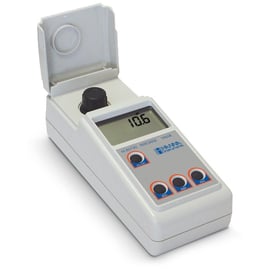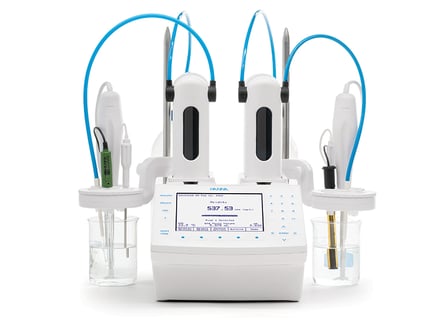Does Your Food Have A Dark Side?
Come to the dark side, there are cookies - at least that's what they say. Well, the dark side of food may not have cookies (though those may not be the healthiest option) - food can go bad without you knowing. Rancidity of foods and oils can creep up on you. Protect your products by testing for Peroxide Value.
What is Rancidity?
Rancidity is the complete or partial oxidation or hydrolysis of fats or oils when they are exposed to heat, air, light, moisture, or bacterial activity. This oxidation is what causes the off flavors and smells that you typically associate with rancid food and will change the quality of your end product.
Many foods can become rancid, including: vegetable oils, olive oils, alternative oils, butters, nuts, grains, flours, baked goods, animal food, animal feeds, and more! Have you ever opened up a bag of dog kibble and been struck by a stale odor? Odds are the fats and protein in the food has gone rancid (especially if it wasn't stored properly). Essentially, anything that contains a fat or oil can be subjected to rancidity. This includes a wide variety of processed products such as tortilla chips, trail mix bars, or cookies.
The more a fat is processed, the more likely it is to become rancid. For example, potato chips that are fried at high temperatures, or cookies made with butter or oil and baked, all have fats exposed to heat. This expedites the oxidation process on the road to rancidity. Additionally, if frying oils are being heated and reused over and over again, they can become rancid quickly. Thus, resulting in a funky, fishy smell as well as off tastes.
How to Identify a Rancid Food?
One of the First Things You Notice - SMELL
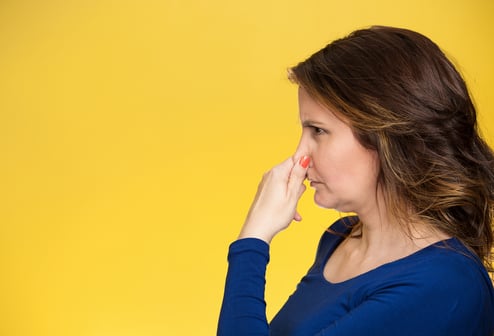
Smell is one of the first things you may notice when you open a package of food. Rancid food can have an unpleasant or stale smell to them. This smell can vary and include odors such as wet cardboard, Play-Doh, or wood varnish. You may be able to detect this in a single food ingredient (i.e. flour) or in the end product.
Does It Have Good TASTE?
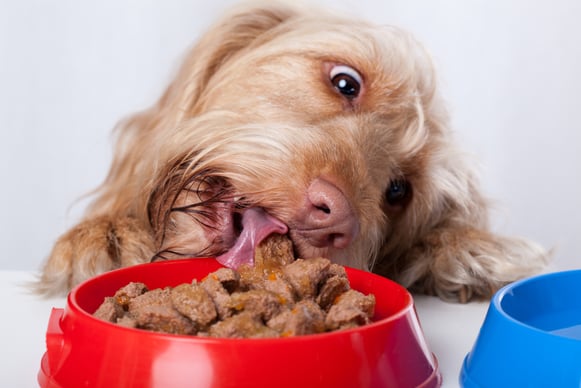
If your food tastes unusually bitter, bland, or cardboard-y, it may be rancid. Sometimes, picking up rancid tastes in foods can be missed or falsely identified. For example, fresh whole grains should have a rich and nutty flavor. However, fresh whole grains tend to have a shorter shelf life and go rancid more quickly than their less healthy counterparts. Having a shorter shelf life means that there can be people who have not tasted the food at its peak freshness, and therefore the less desirable flavor from rancid foods can sometimes be falsely interpreted as the healthier alternative's natural flavor.
Do You Have a Good FEELing
About Your Food?
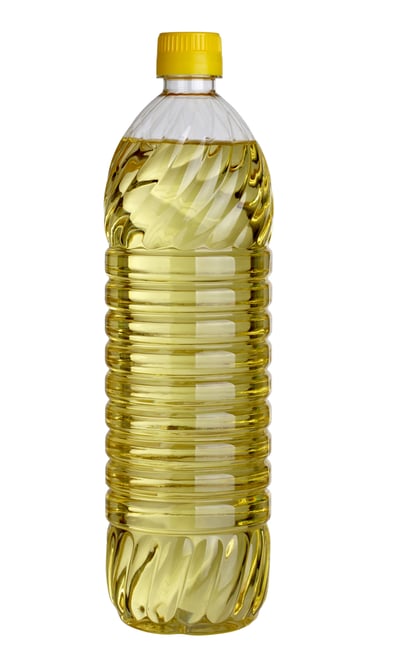
Always ask yourself the question, does my food feel the way it is supposed to? In advanced stages of rancidity other physical characteristics can change in the product as well. Have you ever picked up a bottle of oil and it was sticky? Well, barring the fact that you may have spilled something on the bottle the last time you were cooking, this is a sign that your cooking oil is rancid. A polymerizing reaction occurred in your oil bottle from the oil being exposed to oxygen.
Can You Identify Rancid Food On SIGHT?

Visually looking at a product can give you an idea as to whether or not it may have become rancid. Has there been a color change in the oil or fat (maybe it changed from being light to a darker color)? This kind of color change is a characteristic of rancidity. If you are frying with oil that has become dark, it is time to change it out for some fresh oil to keep your finished foods tasting and smelling fresh.
Is Rancid Food Actually Bad For You?

The dangers of consuming rancid foods are inconclusive. In fact, according to the CDC, "very few outbreaks of gastrointestinal illness associated with the consumption of rancid food have been documented". However, evidence indicates that eating rancid foods may contribute to digestive issues or gastrointestinal illness.
Rancid foods are less nutritious. Oxidation breaks down the fatty acids and destroys the good fats as well as some vitamin content. This can lead to packaged and shelved food having inaccurate labeling (due to the rancidity that has set in by the time of consumption).
Worst of all, experts agree that rancid foods are toxic, and the regular consumption of rancid foods may contribute to inflammatory disease, cardiovascular disease, or even certain cancers.
Should I Be Testing for Rancidity in my Ingredients and Raw Products?
There are many reasons why testing for rancidity should be a big part of your quality assurance and production process. Testing is a sure way to monitor your product’s potential shelf life, stability, and flavor/smell consistency.
If you are purchasing ingredients for your finished product, you will want to make sure that they are the highest quality possible. Money loss from having to get rid of rancid ingredients will surely affect gross profit. If you are purchasing ingredients, you will want to be sure to check incoming oils, fats, nuts, grains, etc., to see how far into the oxidation process those products may be. Having a pre-production inventory that is too large might put you in a situation where you need to dispose of rancid ingredients and re-purchase stock. It will be important to adjust and fine-tune your purchasing, as well as monitor the quality of incoming oils, fats, and ingredients to determine how much stock to keep.
From the provider’s perspective, having the best possible product is key. Checking peroxide value will allow you to back up the freshness and overall quality of your product. Of course, we want to make sure the customer is happy. If a consumer notices off smells or flavors in their food that isn’t consistent with what they expect, they may return and request a refund. Even if a consumer isn’t concerned with a return or refund, their opinion of the product could change forever. If a consumer has a bad experience, they may be less likely to come back to the product in the long run and recommend it to others.
How Do I Test For Rancidity?
Testing for rancidity is a common test. Peroxide Value (PV) is considered the most common and "gold standard" of rancidity testing. Peroxide Value is defined as the amount of peroxide oxygen per kilogram of oil or fat, where the amount of peroxide is reported in milliequivalents or meq. This determination of peroxide oxygen is an indicator of lipid oxidation. Generally, any oils with a Peroxide Value of less than 10 meq are considered fresh while values between 30 and 40 meq are considered rancid. During the beginning stages of rancidification, peroxides rapidly increase. For this reason, Peroxide Value is a very useful and effective test to determine where in the rancidification process your food product is. As Peroxide Value is a good indicator of rancidity due to oxidation, it is a good idea to pair this with a free fatty acid test which gives an indication of rancidity due to microbial activity.
Other tests used to determine rancidity include:
- Free Fatty Acids (FFAs) - Used to determine hydrolytic rancidity (as opposed to oxidation). Free fatty acids can be the by-product of microbial activity.
- p-Anididine (p-AV) - A measure of aldehyde values in fats and oils; particularly unsaturated fats.
- TBA Rancidity (TBAR) - A measure of aldehydes created from the oxidation of fats.
- Oxidative Stability Index (OSI) - Determines the relative resistance of fats or oils to oxidation.
Testing for Peroxide Value (PV)
Photometric
A photometric method is a technique that determines the concentration of a substance using the absorbance of a wavelength. When testing Peroxide Value photometrically, a reagent is added to a sample, where the presence of peroxides will cause a color change. A light source is then passed through the sample and correlates the amount of light absorbed by the color to the concentration of peroxide present in the sample. You can test the PV of olive oil and similar edible oils using a Portable Photometer for Determination of Peroxide Value in Oils.
Titration
A titration method determines the concentration of a substance by reacting a solution with a known concentration (titrant) with an unknown solution (analyte). The subsequent reaction is known and predictable, where the volume of titrant required to react the analyte is used to calculate the concentration. The iodometric titration method for peroxide value of fats and oils is referenced by organizations, such as AOCS and AOAC. For more complex samples, where the fat and oil is bound to other materials, a hexane extraction is required prior to titration.
Hanna automates Peroxide Value of refined and unrefined oils using our Automatic Potentiometric Titrator HI932 per AOAC 965.33 or AOCS Cd 8b-90 reference methods. A sample of the fat or oil is dissolved in the Peroxide Value solvent and then saturated potassium iodide solution is added to the mixture, where any and all peroxide present will react to form iodine. The volume of sodium thiosulfate (titrant) required to react with the generated iodine is then used to calculate the amount of peroxide present. This iodometric reaction can be monitored with an ORP electrode. With the HI932, all calculations are performed automatically and the Peroxide Value concentration of your sample is listed on the screen.
Interested in learning more about testing for Peroxide Value and options available to you? Do you have questions about testing different food sample types? Contact Us Below!
Sources:
CDC https://www.cdc.gov/mmwr/volumes/65/wr/mm6542a4.htm.
Got Questions?
For more information regarding how Hanna Instruments can help you with your testing needs, contact us, as sales@hannainst.com or 1-800-426-6287.
As a leader in innovation Hanna Instruments developed the HALO Wireless pH Meter, which uses Bluetooth Smart Technology to connect to Apple and Android devices running the Hanna Lab App.
Continuing with this tradition, the Hanna Instruments Blog is devoted to sharing the latest in product overviews, how-to guides, and industry specific news to our ever-growing audience.
Contact us at sales@hannainst.com.
